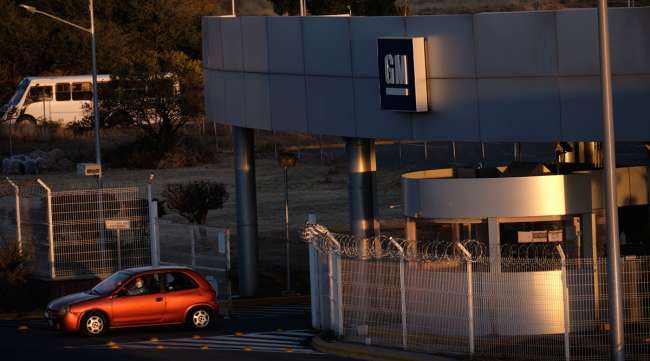Union Workers Question Safety at GM’s Ultium Battery Plant

[Stay on top of transportation news: Get TTNews in your inbox.]
In late June, workers at a General Motors Co. Ultium electric vehicle plant confronted a startling sight: A defective battery was on fire.
The workers raced to put it out, and were able to do so, according to the fire department near the facility in Lordstown, Ohio. While no one faced life-threatening injuries, two people were sent to the hospital for smoke inhalation — adding tension to an already strained relationship between the plant’s workers and its managers.
The United Auto Workers union and Ultium Cells, which is jointly owned by GM and South Korea’s LG Energy Solution, are in the midst of negotiating a labor contract. At the same time, the UAW is hammering out a new, four-year pact with GM and the two other traditional Detroit carmakers. Labor and management already were battling over wages, and the union wants better safety protections following multiple accidents at the plant.
“It’s not just the low pay, these jobs are often dangerous,” UAW President Shawn Fain said in a video that aired July 5. “This is our defining moment. It’s time to build an EV industry that puts workers first.”
The outcome of the talks could have a far-reaching impact. The U.S. is building up its EV industry and will need to attract thousands of workers. Meanwhile, automakers and their battery partners are under pressure to control costs as they expand.
Ultium’s vice president of operations, Tom Gallagher, wrote in a newspaper editorial this week he was “excited” the UAW had organized the Ultium plant and that he “looks forward” to working with the union.
“A competitive, forward-thinking collective bargaining agreement can provide a model for unionization of other U.S. battery cell manufacturing plants and extended electric vehicle supply chain,” he wrote in the July 2 Tribune Chronicle, which serves the Mahoning Valley area in northeastern Ohio where the Ultium plant is located.

UAW President Shawn Fain during a trade alliance meeting in Detroit. (Emily Elconin/Bloomberg News)
The company declined to respond to specific union allegations. “Safety is a top priority each day,” Ultium spokesperson Dallis Tripoulas wrote in an email to Bloomberg News, adding that the plant now has four union members as safety representatives.
Discussions are expected to intensify over the next few months both at Ultium and with the three legacy Detroit automakers. There’s about a 90% chance of a strike targeting one of the three carmakers, and a possibility for a second strike at another, according to an analysis by John Murphy, a Bank of America analyst covering the auto industry. The new labor deal will probably push labor costs up by 30%, he said in a recent report.
Safety Issues
Negotiations between UAW and automakers are more complex than usual. The union already has labor agreements with GM, Ford Motor Co. and Stellantis NV, but those pacts don’t apply to their newer, electric battery plants — like Ultium — because they’re usually joint ventures involving outside partners. UAW had to organize Ultium from scratch and won the election last year.
The union also is learning about the EV industry as it forges deals. Battery cell plants are more like chemical factories than conventional auto production facilities, where injuries are more likely to be from machinery accidents or repetitive tasks.
A year ago, a contractor at the Ultium plant was crushed by an automated crane while working inside the plant, suffering serious injuries, according to Travis Eastham, the local fire station chief. The worker was hospitalized for months and later died of his injuries, Eastham said in a phone interview.
At the time, the company confirmed a subcontractor was injured at the plant, but declined to discuss the incident further.
In a white paper, the union said Ultium worker Gavin Currey was sprayed with toxic gas in early May while working in an area that extracts a poisonous electrolyte compound from battery cells. Currey said in the paper he experienced minor burns to his face and a union official said he was unable to work for three days.

A Silverado EV during a live-streamed GM event at the CES 2022 trade show in Las Vegas. (Bridget Bennett/Bloomberg News)
Another worker, Mandy McCoy, told the union she saw a colleague put toxic waste in a garbage can, emitting fumes that made her and a coworker nauseous. McCoy said her colleague was taken to the hospital.
The Ultium spokesperson declined to comment on any specific incidents or the findings of the white paper.
In all, the union said 22 workers suffered injuries and missed a total of 200 days of work. That equates to 2.2 injuries per hundred workers — twice the average for battery plants, according to Nellie Brown, director of Workplace Health and Safety Programs at Cornell University’s School of Industrial and Labor Relations.
Ultium has paid $68,000 in fines in the past year to the Occupational Safety and Health Administration, double what SK Battery’s plant in Georgia has paid out over the same period. They were for noninjury claims, such as not providing workers with safety data sheets, which explain the nature of chemicals they are handling and include first aid procedures.
There are four other cases open, according to OSHA. The agency won’t release details on those cases because the investigations are ongoing, but a spokesperson said they aren’t related to injuries.
In early May, six battery factory workers in the plant’s electrolyte-mixing department refused to work until the company installed a safety shower in their work area. They were suspended. Ultium offered them a chance to return to work and move to a different area, according to a document reviewed by Bloomberg.
A union official said a shower has been installed and two of the workers have gone back. The Ultium spokesperson said the company has an agreement with the six workers to return to work, but declined to say if the workers are back.
UAW Demands

The makers of Transport Topics’ updated Top 100 For-Hire Carriers list examine trucking’s shifting business environment and what it means for the supply chain. Tune in above or by going to RoadSigns.ttnews.com.
UAW’s Fain is pushing to include Ultium workers in a master labor agreement the union already has with the major Detroit car companies. He has said he believes the automakers are using joint-venture structures, where those agreements don’t apply, to cut pay. Workers in engine plants, who are covered by the master labor agreement, make more than $30 an hour, while battery workers at Ultium max out at about $22.
The automakers disagree with that characterization. GM partnered with LG to obtain much-needed expertise, Gerald Johnson, GM’s executive vice president of global manufacturing, said in an interview in June.
Automakers stand to profit from EV manufacturing, in part, because of incentives in President Joe Biden’s Inflation Reduction Act. GM said it expects to earn $300 million in tax credits this year and aims to build 1 million EVs a year by 2025, which would yield between $3.5 billion and $5.5 billion if they all sell out.
The union wants its cut.
“A just transition must include standards for our members and future workers,” Fain said. Otherwise “taxpayers are going to continue to funnel over $1 billion a year to Ultium despite their paying poverty wages and having horrifying health and safety conditions.”
— With assistance from Sam Kim.
Want more news? Listen to today's daily briefing below or go here for more info:




